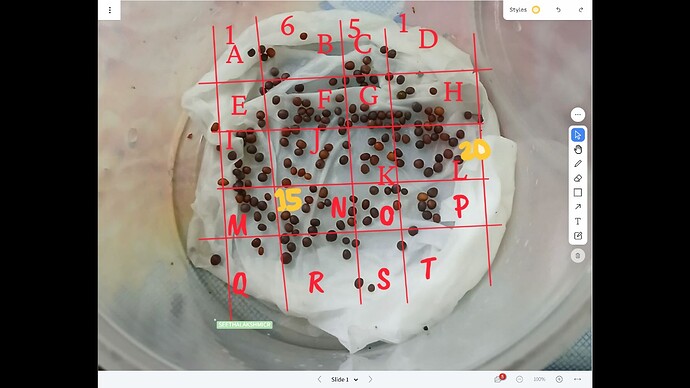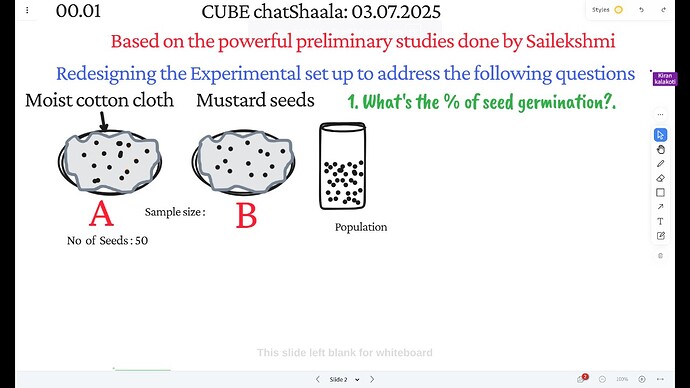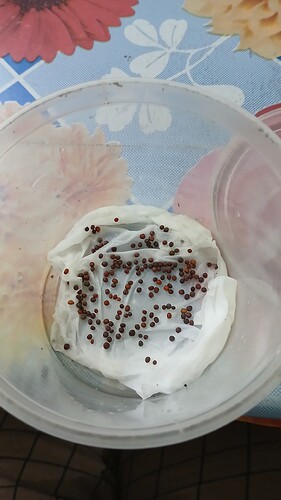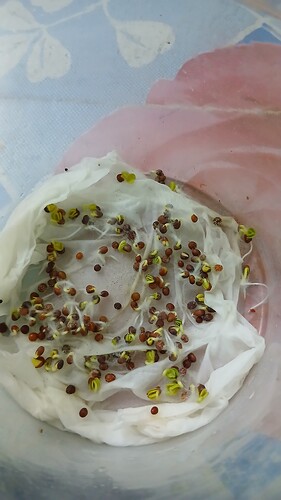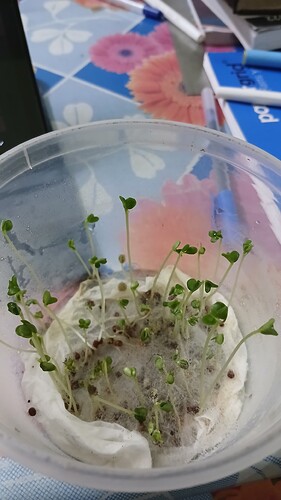Focused on Mustard Seed Germination Studies by Sailekshmi
Today’s ChatShaala revolved around the experimental refinement of mustard seed germination studies conducted by Sailekshmi, building on her promising preliminary results. A clear effort was made to transition from anecdotal observation to systematic scientific inquiry.
![]() Experimental Redesign
Experimental Redesign
The setup involved placing mustard seeds on moist cotton within a transparent container, replicating simple yet controlled conditions for seed germination. A gridded mapping system was introduced, where the experimental surface was divided into coordinates to track seed distribution and responses over time. This ensures data can be quantified and localized, making comparisons more precise.
Two sample trays ( A and B ) were discussed, each with 50 seeds, representing random selections from a larger seed population. This helped link sample-level results to population-level patterns. Yellow labels such as “ 15 ” and “ 20” within the grid appear to mark localized seed counts or early-stage germination events.
![]() Sequential Observations
Sequential Observations
A clear progression was captured photographically :
- Image 1 : Seeds just placed – dry but ready on moist cotton.
- Image 2 : Early germination – seed coats breaking, emergence of radicles.
- Image 3 : Advanced germination – hypocotyls growing vertically, some fungal growth visible ( indicating humidity saturation and potential need for adjustment).
This time-lapse evidence provides a powerful narrative of developmental change, reinforcing the reliability of the experimental design.
![]() Scientific Relevance
Scientific Relevance
The ChatShaala emphasized:
– Using grids for quantitative recording
– Importance of defining sample sizes
– Tracking germination rates across time
Recognizing contamination or fungal presence as an experimental variable
This elevates the work from a simple observation to a replicable model experiment, suitable for hypothesis testing ( e.g., % germination vs. time, seed density vs. fungal growth, etc. ).
![]() Queries for Further Exploration
Queries for Further Exploration
- Seed Count Verification
Have we counted the total number of seeds per grid cell at the start?
What’s the current count of germinated vs. non-germinated seeds?
- Understanding Labels
Do the yellow numbers “15” ( in M–N row ) and “20” ( in L column ) represent seed counts or germination events?
Can we get a time-log of when germination started in each cell?
- Population Representativeness
How was the sample of 50 seeds drawn from the population? Randomly or by any criteria?
Are both samples (A and B) behaving similarly or showing variation?
- Data Management
Is there a daily logbook or sheet recording the changes seen in each cell?
Would it help to color-code germinated vs. ungerminated seeds in the next image overlay?
- Growth and Fungal Observation
Some fungal growth is visible in the later stage. How might this impact germination rate or seedling health?
Should a fungicide control experiment be considered in future trials?
- Scaling the Study
Are there plans to compare seeds from different mustard brands/sources to see if germination varies?
Could this method be adapted to study the inheritance of tall vs. short traits, inspired by Mendel’s pea experiments?
![]() Reference
Reference
@Arunan @KiranKalakotiR @Suraj @2020ugchsncnseethala @akanksha @Chitralekha @Akantidas @sakshiconsultant2002 and others.
